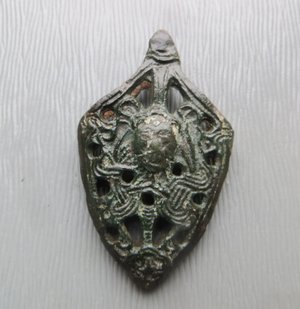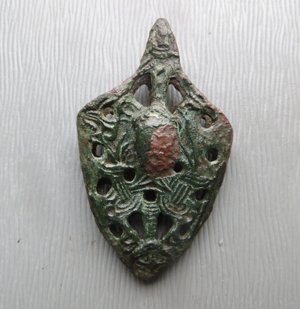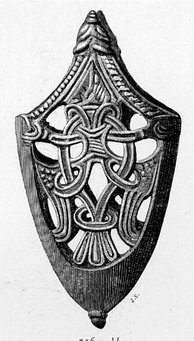Viking Age sword chapes - always a bit of a mystery
In this week's blog I'd like to take you to the somewhat mysterious world of a part of the adornment of the viking sword, the sword chape.
Charlotte Hedenstierna-Jonsson wrote an very interesting article in 2002, called 'A group of Viking Age sword chapes reflecting the political geography of the time' in wich she addresses this type of artefact as 'scarce'. Written in 2002, I have asked her if - in her opinion - this is still the case nowadays.
This is the case, because there is a viral market on viking sword chapes wich hadn't been documented at musea etc. The two sword chapes published here, are an example of that market. Of course, just for the sake of this overall overview of excisting sword chapes, I recommend each serious collector always to get the provenance of a sword chape. Generally, in my opinion, it doesn't matter if an artefact is in private collection hands, but the private collector has to do his utmost efford to get to know and register the provenance of an artefact for future's sake.
The viking sword chapes published here is a quick overview of some of the different types of them. Individually I will address them somewhat more in detail in one of the future blogs - as I did with the viking sword chape of Falcon Style and the viking sword chape of East-Prussian oriental motif style before.
The sword chape above is one of a rare type, in Borre Style. This sword chape deserved to be addressed more indepth on itself, so keep an eye on forthcoming blogs..
Adressed in the mentioned article, there were - at that time - only 5 examples of this type belonging to the so called 'Sub-group B'. Without stating that my example making that 6, it is clear this is a very rare type indeed. To be continued..
Viking sword chapes and their distribution
Locations of sword chape finds are spread over an extensive geographical area from Denmark, to the north of Sweden, going eastwards into nowadays Eastern Europe as far south to the Black Sea. The mystery of this type of artefact lies within the fact, that some of the types - as the anthropomorphic figure types - were found in settlements, rather than in graves. Why were they seperated (accidentally or deliberately ?) from their swords ? Was their function a cufflink alike ? Worn at the sword adornment on special occasions ? A special occasion whereby it had its function as a horse pendant alike, impressing other people and making oneself distinctive from the other (people) ?
In the majority of cases - that why the provenance and the circumstances how an artfact was being excavated or found by chance are so important for our knowledge - this is not certain.
The second viking sword chape - wich also be addressed in a future blog - is of a type called the 'Valleberga type' by Peter Paulsen called 'A Scandinavian group'. Wich adresses a problem in our up to date knowledge and overall present view on viking sword chapes. Being published already in 1953, our knowledge and interpretation since then had increased of course, and a new publication with an up to date overall summary is very much needed.
As Fedir Androshchuk published all 832 (!) known Scandinavian swords in Viking swords: Swords and social aspects of weaponry in Viking Age societies, I would recommend scholars to publish a sortalike publication on Viking Age sword chapes indeed. 832 known vikings swords alone in Scandinavia addresses the rarity of sword chapes regarding their far lesser known number in my opinion.
Though, I am curious what Charlotte Hedenstierna-Jonson has to say about this and will add it to this article when I receive a reply from her.
Scabbard chapes
Described here as 'scabbard chapes' some of the finds within Scandinavia are adressed in his book, but besides the very worthfull publications of Charlotte Hedenstierna-Jonson and the Peter Paulsen's book, no more up to date information I cannot share with you yet.
See for the publications Of Charlotte Hedenstierna-Jonson:
A group of Viking Age sword chapes reflecting the political geography of the time. Journal of Nordic Archaeological Science, 13, pp. 103-112 (2002) as well as
Rus', Varangians and Birka Warriors from the same author adressing the eastern connection and showing us several images of viking sword chapes.
Diverse Russian books like Scandinavian Antiquities of Southern Rus, from Fedrir Androshchuk and Volodymyr Zotsenko (2012) are addressing viking sword chapes, but a course of Russian is sorely needed then ;)
S. Yu. Kainov 2009, Sword’s scabbard chapes from Gnezdovo
It would lead too far summing up all books where known or less known sword chapes are being published within, but if you know a reference to a book/publication not addressed here, let me know at vikingsandartefacts@yahoo.com.
Thomas Kamphuis
May 1th 2015.
Well. I could have been with these stones until after dark, but as my wife wanted to travel on.. well.. I see you again, some day, hogback stones from Gosforth. And if you happen to be there one day, do not forget that monument on the outside...
Further on with the Cumbrian hogbacktour !
In - yes, luckily again in - St. Peter's church in Heysham, there is a truly beautiful hogback stone. The guide told us, it had been studyied by Thor Ewing, a writer, in 2000. in 'Understanding the Heysham hogback' A tenth century sculpted stone monument and its context (link), Thor Ewing tells in detail what he dicovered on the both sides of this hogback stone.
Just being brought in the church as late as the 1970's accompanied with some protest here and there among the church visitors, considered as being a token of old paganism, it had been remarkably nice preserved, and a lot of detail can be seen, still. Truly worthwile a visit.
I had a small debate with the guide in the church if the - zoomorphic, in my opinion - faces on the sides were lions (or hippo's). The guide doubted if the vikings could have known about lions. Well I guess so, concerning the runes on the Ancient Greek lion statue at the Arsenal, Venice. For example. Vikings did travel south..
But when he told me he was doubting the vikings 'discovered' (as the native inhabitants were of course, in the first place) America before Columbus, I decided to rest my case..
One has to know when to start and to end a conversation ..
Just discovered the book in a bookstore written by Geoff Holder - The guide to the mysterious Lake District, I knew there had to be another hogback stone in Lowther, St. Micheal's Church. With a promising image described in the text of 'a naval and a land-based force of shield-bearing vikings above a fish and what might be a coiled sea serpent. On the reverse is a row of female figures with snakes, possibly a representation of the hideous hag Hel'. Wow. If that did not sound as a true pagan promised land ..
Not complaing too much after all we have seen, this visit was the dissapointing one of them all. But if you wife states 'I am happy to have seen them' and I am answering 'Measuring is knowing' and the even more obligate verb 'handling 'if we did not see it at all, we wouldn't have known anything at all of how they were looking' the glass was again half full, at the last day of our journey..
The hogback stone appeared to be just being tolerated within the entrance segment part of the church. As something you never use anymore but you do not throw away - entirely. That sort of feeling emerged when seeing this hogback asylum seekers.. Bed, bath and bread, ás we say in Dutch, but no luxury at all and standing on some outcuts of wood, you would balance the table with at home..
Come on, St. Micheal's Church.. care a bit more of your 'children' !
This hogback stone was moved in the church in 1907. Hogback stones layed partially buried in the churchyard before it was dug up and moved into the church.
The promising depiction of a longship - as certainly can be seen after some studying - see http://vikingminds.co.uk/pages/longship
we have missed !
The stone itself is (157 x 50 x 30 cm) and very worn.
The hogback stones in Cumbria - very diverse in quality, but everyone worth a visit ! Especially on a gloomy day in late October ...
The churches to visit - see photos of resp. St. Andrew's church in Penrith, St. Mary's church in Gosforth, St. Peter's church in Heysham and St. Micheal's church in Lowther.
Did I miss out on another one in Cumbria ? Let me know !
In a next blog I will take you to four - still remaining utterly mysterious- statues 'guarding' the graveyard of St. Andrew's church in Dacre..
For the last blog of October 9th see this link.
References: (as always, links to where the books can be ordered are attached).
Edwards, B.J.N. Vikings in North West England - The artifacts (1998);
Emery, Gordon, CURIOUS CUMBRIA, The Lake District & Beyond: A celebration of Cumbria (2023)
Ewing, T. 'Understanding the Heysham hogback' A tenth century sculpted stone monument and its context ;
Hall, R. Viking Age archaeology in Britain and Ireland (first printed 1990, reprinted with amendments in 1995);
Holder, G. The guide to the mysterious Lake District (2009)
possibly also (as there within the part of Cumbria dealing with Carlisle, the Eden Valley, Barrow-in-Furness, Whitehaven and the west coast is being dealed with)
Holder, G. Paranormal Cumbria (2010)
http://vikingminds.co.uk/pages/longship


